Financial Impact of Data Entry Errors: A Westpac Bank Case Study
VerifiedAdded on 2023/01/13
|7
|2346
|69
Case Study
AI Summary
This case study examines a significant data entry error at Westpac Bank, where a loan was incorrectly recorded, leading to substantial financial repercussions. The assignment analyzes the effectiveness of both manual and computer-based data entry systems, highlighting the advantages and disadvantages of each. It explores the role of internal auditors in preventing such errors and recommends improvements to Westpac's internal control systems, including enhanced checking procedures, automation, and improved input control designs. The study emphasizes the importance of accurate data entry, robust financial controls, and the potential for significant financial losses due to human error in financial institutions. The analysis includes references to academic literature that supports the findings and recommendations for preventing future incidents.
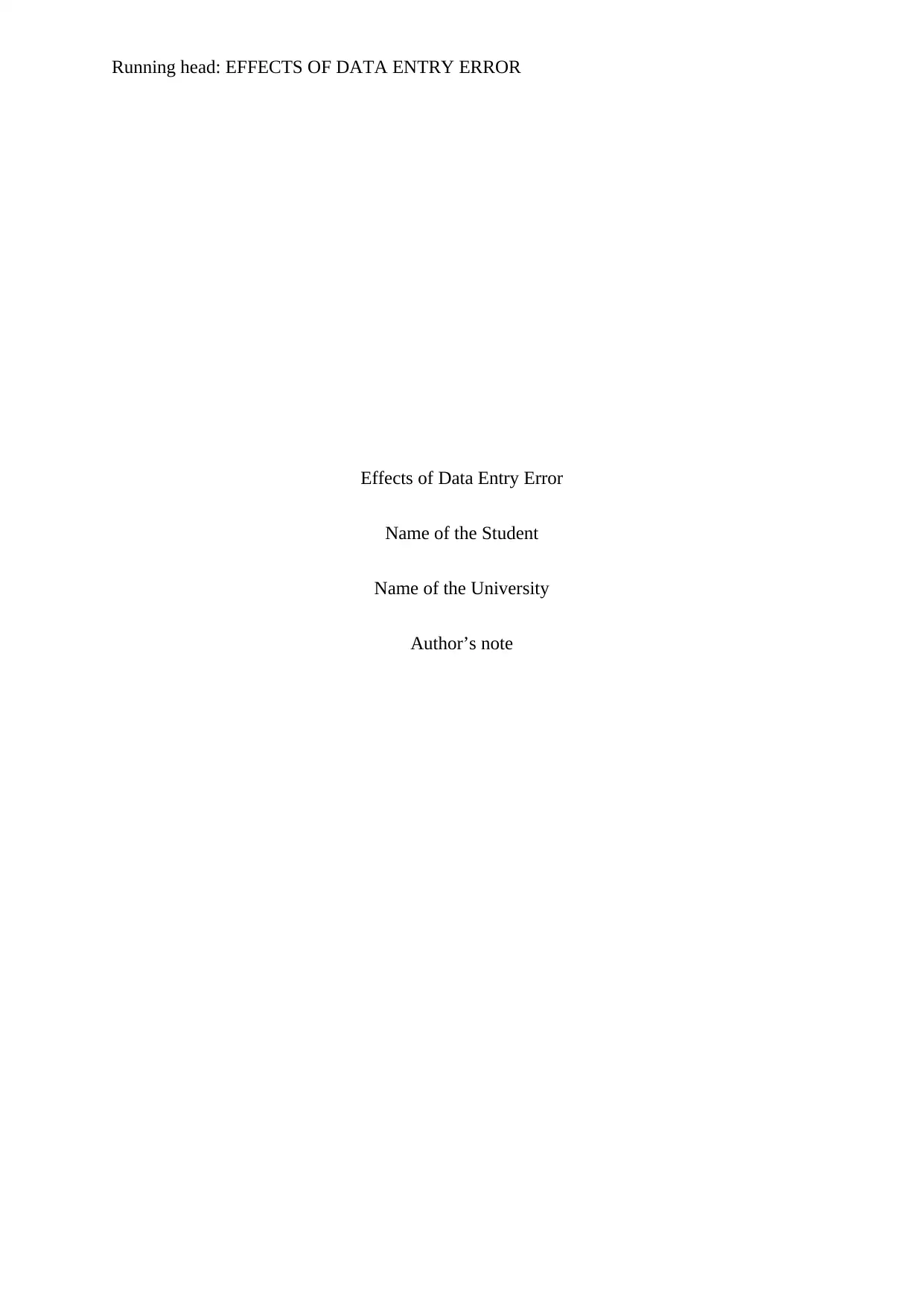
Running head: EFFECTS OF DATA ENTRY ERROR
Effects of Data Entry Error
Name of the Student
Name of the University
Author’s note
Effects of Data Entry Error
Name of the Student
Name of the University
Author’s note
Paraphrase This Document
Need a fresh take? Get an instant paraphrase of this document with our AI Paraphraser
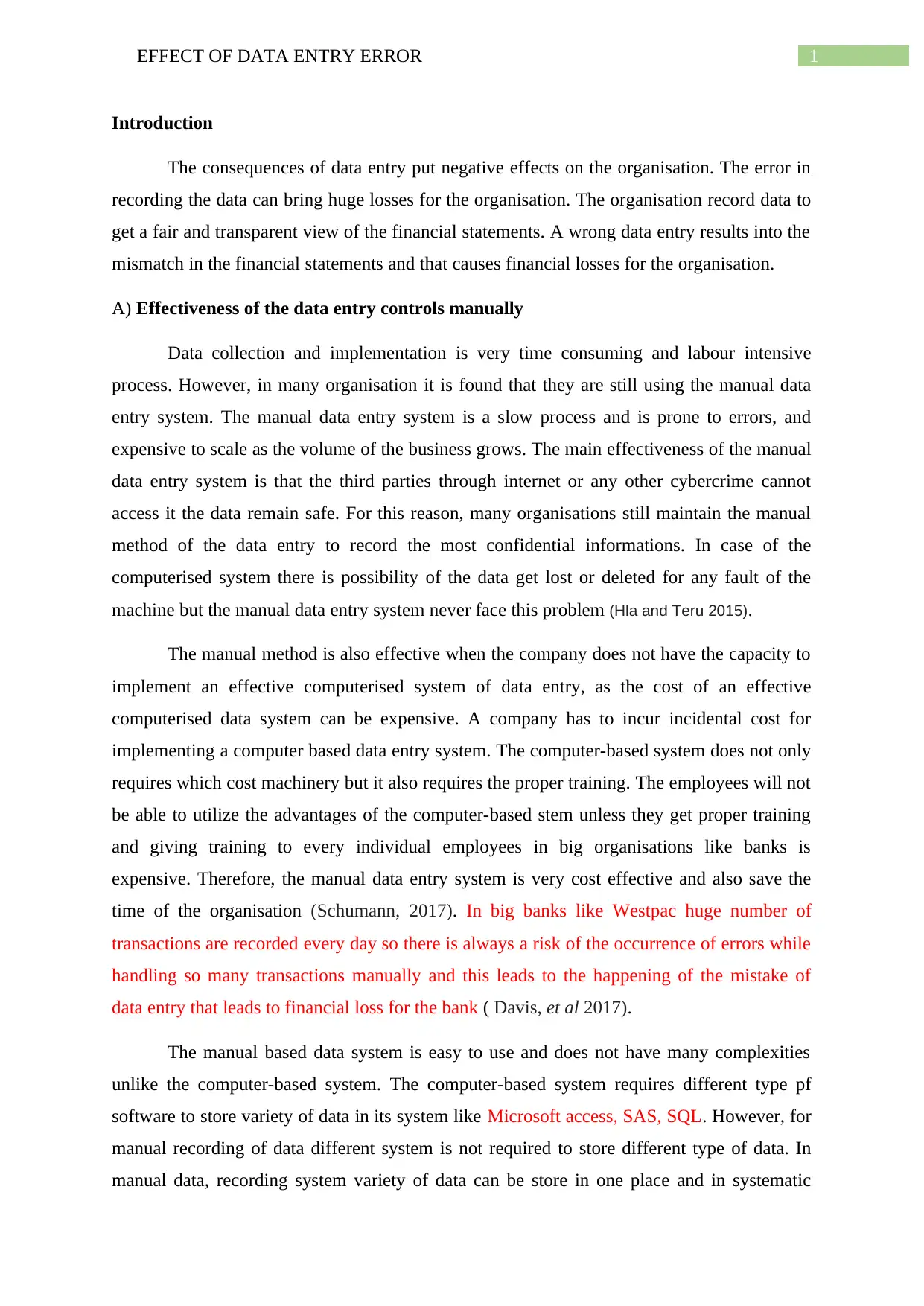
1EFFECT OF DATA ENTRY ERROR
Introduction
The consequences of data entry put negative effects on the organisation. The error in
recording the data can bring huge losses for the organisation. The organisation record data to
get a fair and transparent view of the financial statements. A wrong data entry results into the
mismatch in the financial statements and that causes financial losses for the organisation.
A) Effectiveness of the data entry controls manually
Data collection and implementation is very time consuming and labour intensive
process. However, in many organisation it is found that they are still using the manual data
entry system. The manual data entry system is a slow process and is prone to errors, and
expensive to scale as the volume of the business grows. The main effectiveness of the manual
data entry system is that the third parties through internet or any other cybercrime cannot
access it the data remain safe. For this reason, many organisations still maintain the manual
method of the data entry to record the most confidential informations. In case of the
computerised system there is possibility of the data get lost or deleted for any fault of the
machine but the manual data entry system never face this problem (Hla and Teru 2015).
The manual method is also effective when the company does not have the capacity to
implement an effective computerised system of data entry, as the cost of an effective
computerised data system can be expensive. A company has to incur incidental cost for
implementing a computer based data entry system. The computer-based system does not only
requires which cost machinery but it also requires the proper training. The employees will not
be able to utilize the advantages of the computer-based stem unless they get proper training
and giving training to every individual employees in big organisations like banks is
expensive. Therefore, the manual data entry system is very cost effective and also save the
time of the organisation (Schumann, 2017). In big banks like Westpac huge number of
transactions are recorded every day so there is always a risk of the occurrence of errors while
handling so many transactions manually and this leads to the happening of the mistake of
data entry that leads to financial loss for the bank ( Davis, et al 2017).
The manual based data system is easy to use and does not have many complexities
unlike the computer-based system. The computer-based system requires different type pf
software to store variety of data in its system like Microsoft access, SAS, SQL. However, for
manual recording of data different system is not required to store different type of data. In
manual data, recording system variety of data can be store in one place and in systematic
Introduction
The consequences of data entry put negative effects on the organisation. The error in
recording the data can bring huge losses for the organisation. The organisation record data to
get a fair and transparent view of the financial statements. A wrong data entry results into the
mismatch in the financial statements and that causes financial losses for the organisation.
A) Effectiveness of the data entry controls manually
Data collection and implementation is very time consuming and labour intensive
process. However, in many organisation it is found that they are still using the manual data
entry system. The manual data entry system is a slow process and is prone to errors, and
expensive to scale as the volume of the business grows. The main effectiveness of the manual
data entry system is that the third parties through internet or any other cybercrime cannot
access it the data remain safe. For this reason, many organisations still maintain the manual
method of the data entry to record the most confidential informations. In case of the
computerised system there is possibility of the data get lost or deleted for any fault of the
machine but the manual data entry system never face this problem (Hla and Teru 2015).
The manual method is also effective when the company does not have the capacity to
implement an effective computerised system of data entry, as the cost of an effective
computerised data system can be expensive. A company has to incur incidental cost for
implementing a computer based data entry system. The computer-based system does not only
requires which cost machinery but it also requires the proper training. The employees will not
be able to utilize the advantages of the computer-based stem unless they get proper training
and giving training to every individual employees in big organisations like banks is
expensive. Therefore, the manual data entry system is very cost effective and also save the
time of the organisation (Schumann, 2017). In big banks like Westpac huge number of
transactions are recorded every day so there is always a risk of the occurrence of errors while
handling so many transactions manually and this leads to the happening of the mistake of
data entry that leads to financial loss for the bank ( Davis, et al 2017).
The manual based data system is easy to use and does not have many complexities
unlike the computer-based system. The computer-based system requires different type pf
software to store variety of data in its system like Microsoft access, SAS, SQL. However, for
manual recording of data different system is not required to store different type of data. In
manual data, recording system variety of data can be store in one place and in systematic
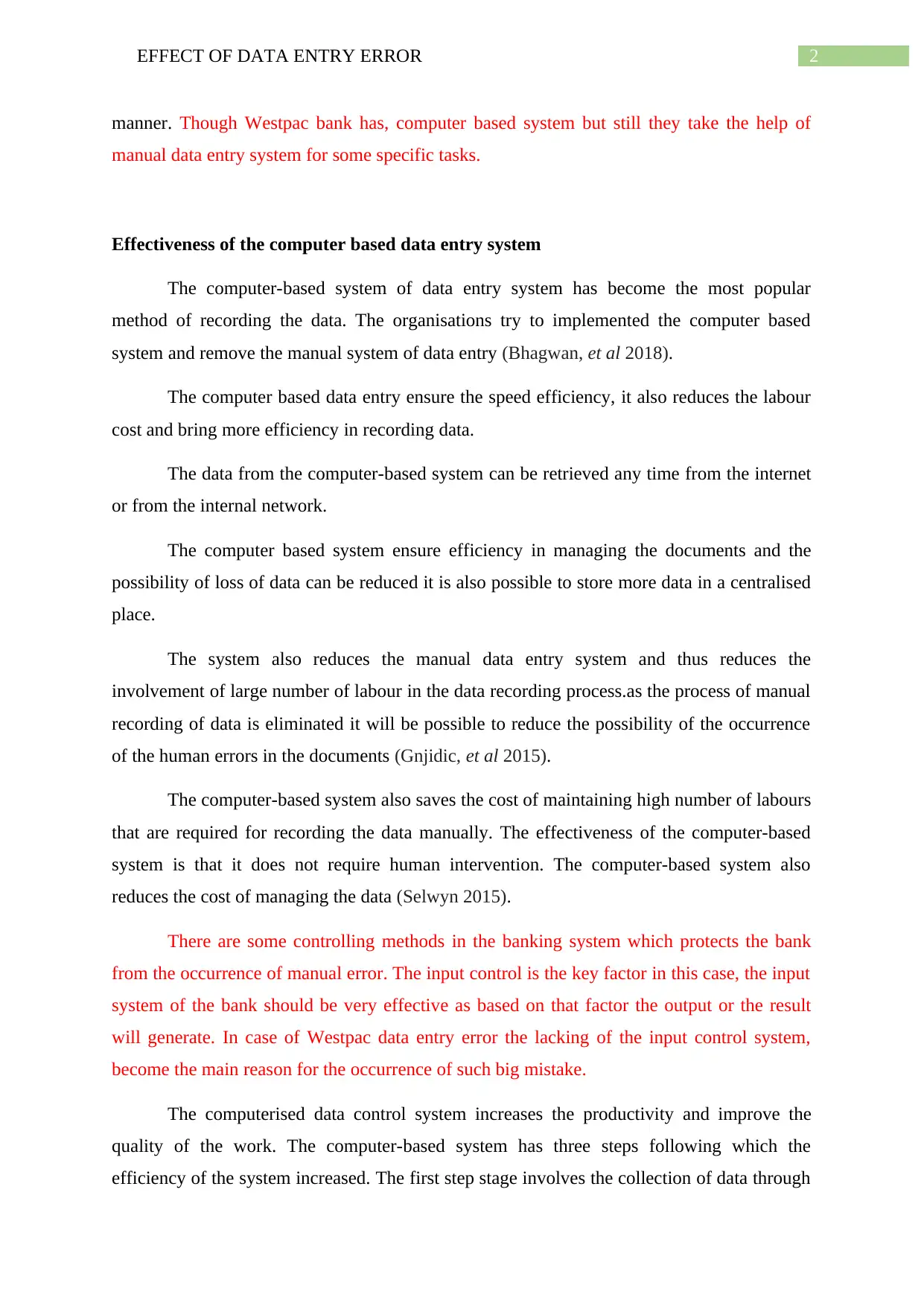
2EFFECT OF DATA ENTRY ERROR
manner. Though Westpac bank has, computer based system but still they take the help of
manual data entry system for some specific tasks.
Effectiveness of the computer based data entry system
The computer-based system of data entry system has become the most popular
method of recording the data. The organisations try to implemented the computer based
system and remove the manual system of data entry (Bhagwan, et al 2018).
The computer based data entry ensure the speed efficiency, it also reduces the labour
cost and bring more efficiency in recording data.
The data from the computer-based system can be retrieved any time from the internet
or from the internal network.
The computer based system ensure efficiency in managing the documents and the
possibility of loss of data can be reduced it is also possible to store more data in a centralised
place.
The system also reduces the manual data entry system and thus reduces the
involvement of large number of labour in the data recording process.as the process of manual
recording of data is eliminated it will be possible to reduce the possibility of the occurrence
of the human errors in the documents (Gnjidic, et al 2015).
The computer-based system also saves the cost of maintaining high number of labours
that are required for recording the data manually. The effectiveness of the computer-based
system is that it does not require human intervention. The computer-based system also
reduces the cost of managing the data (Selwyn 2015).
There are some controlling methods in the banking system which protects the bank
from the occurrence of manual error. The input control is the key factor in this case, the input
system of the bank should be very effective as based on that factor the output or the result
will generate. In case of Westpac data entry error the lacking of the input control system,
become the main reason for the occurrence of such big mistake.
The computerised data control system increases the productivity and improve the
quality of the work. The computer-based system has three steps following which the
efficiency of the system increased. The first step stage involves the collection of data through
manner. Though Westpac bank has, computer based system but still they take the help of
manual data entry system for some specific tasks.
Effectiveness of the computer based data entry system
The computer-based system of data entry system has become the most popular
method of recording the data. The organisations try to implemented the computer based
system and remove the manual system of data entry (Bhagwan, et al 2018).
The computer based data entry ensure the speed efficiency, it also reduces the labour
cost and bring more efficiency in recording data.
The data from the computer-based system can be retrieved any time from the internet
or from the internal network.
The computer based system ensure efficiency in managing the documents and the
possibility of loss of data can be reduced it is also possible to store more data in a centralised
place.
The system also reduces the manual data entry system and thus reduces the
involvement of large number of labour in the data recording process.as the process of manual
recording of data is eliminated it will be possible to reduce the possibility of the occurrence
of the human errors in the documents (Gnjidic, et al 2015).
The computer-based system also saves the cost of maintaining high number of labours
that are required for recording the data manually. The effectiveness of the computer-based
system is that it does not require human intervention. The computer-based system also
reduces the cost of managing the data (Selwyn 2015).
There are some controlling methods in the banking system which protects the bank
from the occurrence of manual error. The input control is the key factor in this case, the input
system of the bank should be very effective as based on that factor the output or the result
will generate. In case of Westpac data entry error the lacking of the input control system,
become the main reason for the occurrence of such big mistake.
The computerised data control system increases the productivity and improve the
quality of the work. The computer-based system has three steps following which the
efficiency of the system increased. The first step stage involves the collection of data through
⊘ This is a preview!⊘
Do you want full access?
Subscribe today to unlock all pages.

Trusted by 1+ million students worldwide
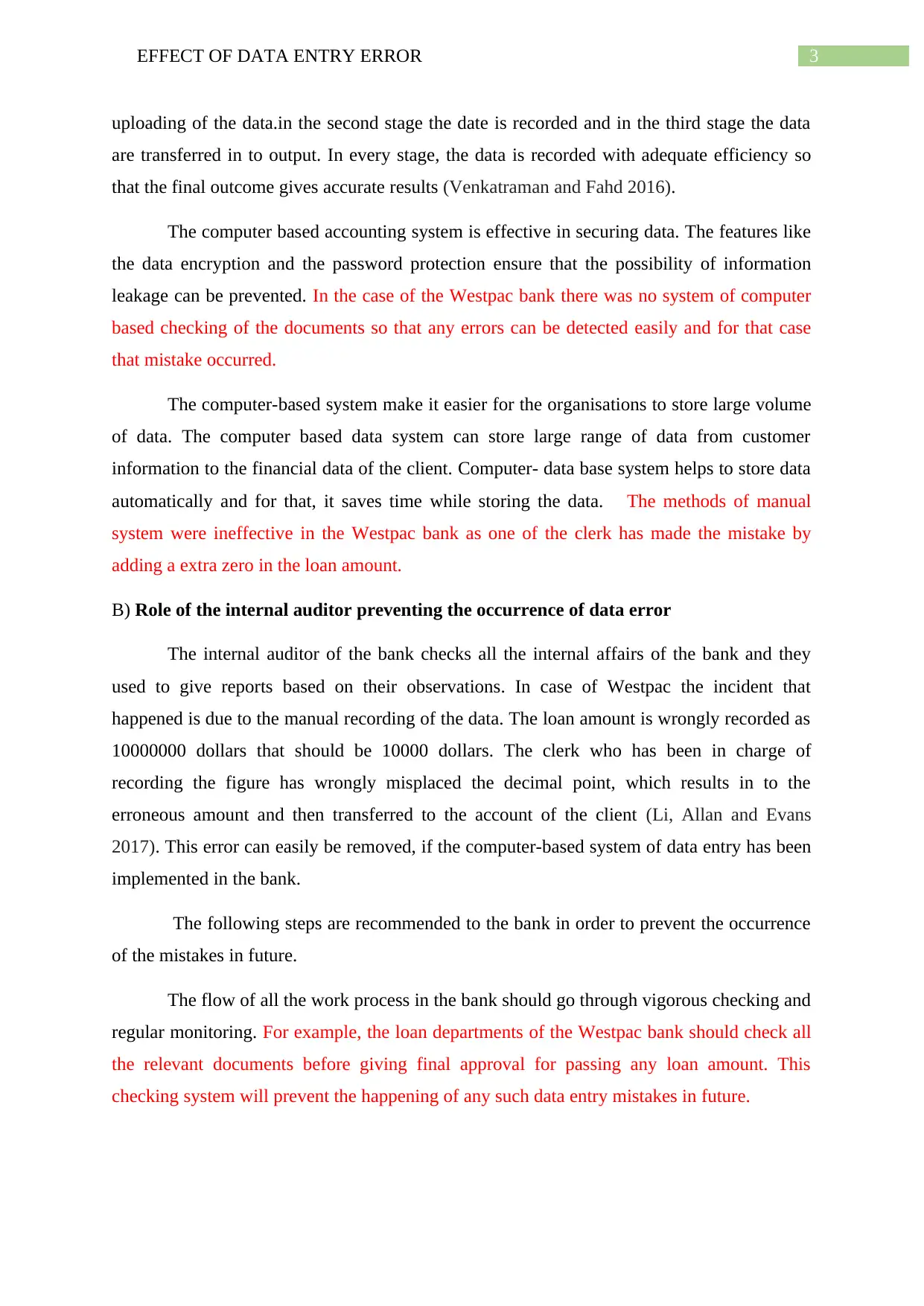
3EFFECT OF DATA ENTRY ERROR
uploading of the data.in the second stage the date is recorded and in the third stage the data
are transferred in to output. In every stage, the data is recorded with adequate efficiency so
that the final outcome gives accurate results (Venkatraman and Fahd 2016).
The computer based accounting system is effective in securing data. The features like
the data encryption and the password protection ensure that the possibility of information
leakage can be prevented. In the case of the Westpac bank there was no system of computer
based checking of the documents so that any errors can be detected easily and for that case
that mistake occurred.
The computer-based system make it easier for the organisations to store large volume
of data. The computer based data system can store large range of data from customer
information to the financial data of the client. Computer- data base system helps to store data
automatically and for that, it saves time while storing the data. The methods of manual
system were ineffective in the Westpac bank as one of the clerk has made the mistake by
adding a extra zero in the loan amount.
B) Role of the internal auditor preventing the occurrence of data error
The internal auditor of the bank checks all the internal affairs of the bank and they
used to give reports based on their observations. In case of Westpac the incident that
happened is due to the manual recording of the data. The loan amount is wrongly recorded as
10000000 dollars that should be 10000 dollars. The clerk who has been in charge of
recording the figure has wrongly misplaced the decimal point, which results in to the
erroneous amount and then transferred to the account of the client (Li, Allan and Evans
2017). This error can easily be removed, if the computer-based system of data entry has been
implemented in the bank.
The following steps are recommended to the bank in order to prevent the occurrence
of the mistakes in future.
The flow of all the work process in the bank should go through vigorous checking and
regular monitoring. For example, the loan departments of the Westpac bank should check all
the relevant documents before giving final approval for passing any loan amount. This
checking system will prevent the happening of any such data entry mistakes in future.
uploading of the data.in the second stage the date is recorded and in the third stage the data
are transferred in to output. In every stage, the data is recorded with adequate efficiency so
that the final outcome gives accurate results (Venkatraman and Fahd 2016).
The computer based accounting system is effective in securing data. The features like
the data encryption and the password protection ensure that the possibility of information
leakage can be prevented. In the case of the Westpac bank there was no system of computer
based checking of the documents so that any errors can be detected easily and for that case
that mistake occurred.
The computer-based system make it easier for the organisations to store large volume
of data. The computer based data system can store large range of data from customer
information to the financial data of the client. Computer- data base system helps to store data
automatically and for that, it saves time while storing the data. The methods of manual
system were ineffective in the Westpac bank as one of the clerk has made the mistake by
adding a extra zero in the loan amount.
B) Role of the internal auditor preventing the occurrence of data error
The internal auditor of the bank checks all the internal affairs of the bank and they
used to give reports based on their observations. In case of Westpac the incident that
happened is due to the manual recording of the data. The loan amount is wrongly recorded as
10000000 dollars that should be 10000 dollars. The clerk who has been in charge of
recording the figure has wrongly misplaced the decimal point, which results in to the
erroneous amount and then transferred to the account of the client (Li, Allan and Evans
2017). This error can easily be removed, if the computer-based system of data entry has been
implemented in the bank.
The following steps are recommended to the bank in order to prevent the occurrence
of the mistakes in future.
The flow of all the work process in the bank should go through vigorous checking and
regular monitoring. For example, the loan departments of the Westpac bank should check all
the relevant documents before giving final approval for passing any loan amount. This
checking system will prevent the happening of any such data entry mistakes in future.
Paraphrase This Document
Need a fresh take? Get an instant paraphrase of this document with our AI Paraphraser
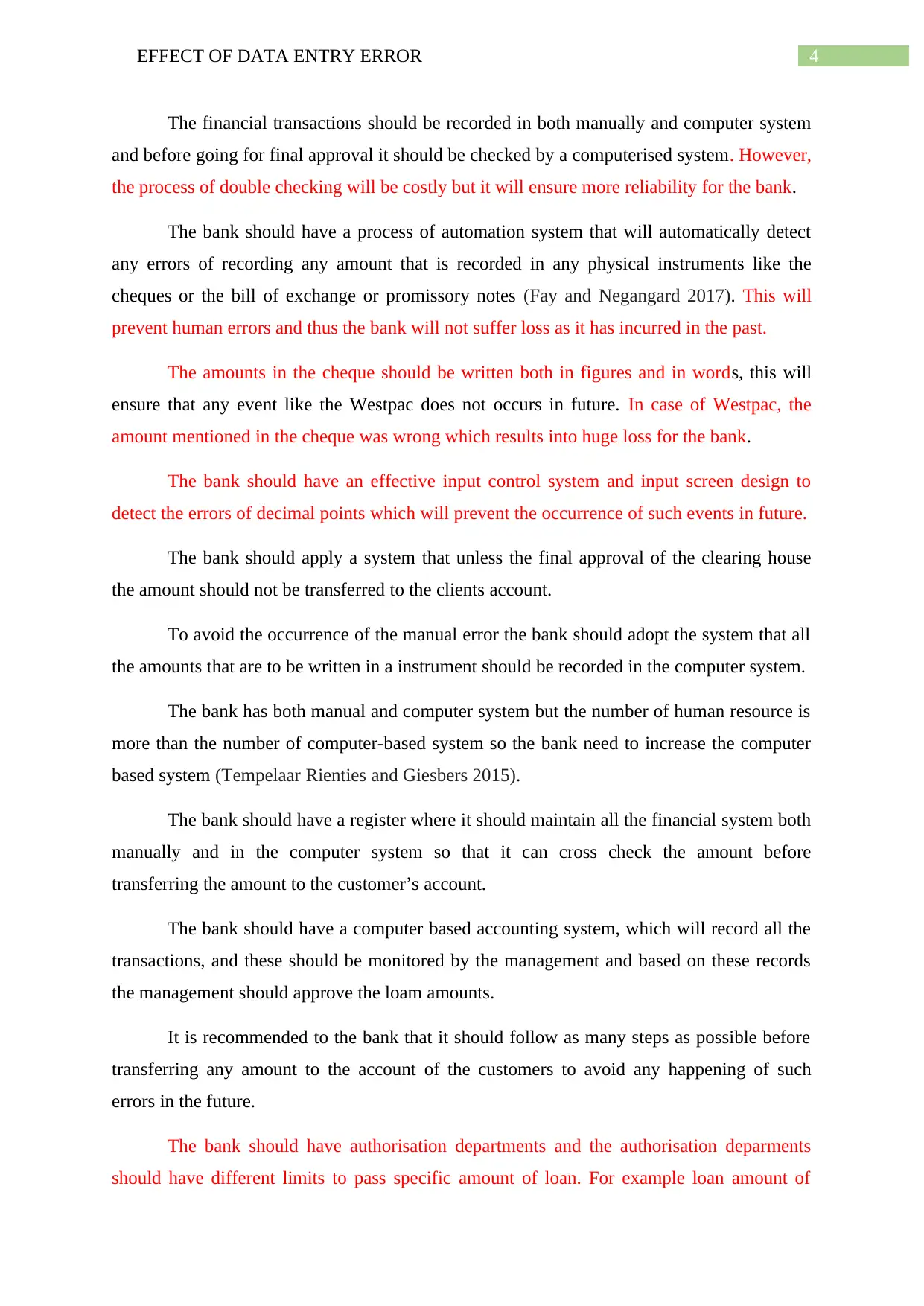
4EFFECT OF DATA ENTRY ERROR
The financial transactions should be recorded in both manually and computer system
and before going for final approval it should be checked by a computerised system. However,
the process of double checking will be costly but it will ensure more reliability for the bank.
The bank should have a process of automation system that will automatically detect
any errors of recording any amount that is recorded in any physical instruments like the
cheques or the bill of exchange or promissory notes (Fay and Negangard 2017). This will
prevent human errors and thus the bank will not suffer loss as it has incurred in the past.
The amounts in the cheque should be written both in figures and in words, this will
ensure that any event like the Westpac does not occurs in future. In case of Westpac, the
amount mentioned in the cheque was wrong which results into huge loss for the bank.
The bank should have an effective input control system and input screen design to
detect the errors of decimal points which will prevent the occurrence of such events in future.
The bank should apply a system that unless the final approval of the clearing house
the amount should not be transferred to the clients account.
To avoid the occurrence of the manual error the bank should adopt the system that all
the amounts that are to be written in a instrument should be recorded in the computer system.
The bank has both manual and computer system but the number of human resource is
more than the number of computer-based system so the bank need to increase the computer
based system (Tempelaar Rienties and Giesbers 2015).
The bank should have a register where it should maintain all the financial system both
manually and in the computer system so that it can cross check the amount before
transferring the amount to the customer’s account.
The bank should have a computer based accounting system, which will record all the
transactions, and these should be monitored by the management and based on these records
the management should approve the loam amounts.
It is recommended to the bank that it should follow as many steps as possible before
transferring any amount to the account of the customers to avoid any happening of such
errors in the future.
The bank should have authorisation departments and the authorisation deparments
should have different limits to pass specific amount of loan. For example loan amount of
The financial transactions should be recorded in both manually and computer system
and before going for final approval it should be checked by a computerised system. However,
the process of double checking will be costly but it will ensure more reliability for the bank.
The bank should have a process of automation system that will automatically detect
any errors of recording any amount that is recorded in any physical instruments like the
cheques or the bill of exchange or promissory notes (Fay and Negangard 2017). This will
prevent human errors and thus the bank will not suffer loss as it has incurred in the past.
The amounts in the cheque should be written both in figures and in words, this will
ensure that any event like the Westpac does not occurs in future. In case of Westpac, the
amount mentioned in the cheque was wrong which results into huge loss for the bank.
The bank should have an effective input control system and input screen design to
detect the errors of decimal points which will prevent the occurrence of such events in future.
The bank should apply a system that unless the final approval of the clearing house
the amount should not be transferred to the clients account.
To avoid the occurrence of the manual error the bank should adopt the system that all
the amounts that are to be written in a instrument should be recorded in the computer system.
The bank has both manual and computer system but the number of human resource is
more than the number of computer-based system so the bank need to increase the computer
based system (Tempelaar Rienties and Giesbers 2015).
The bank should have a register where it should maintain all the financial system both
manually and in the computer system so that it can cross check the amount before
transferring the amount to the customer’s account.
The bank should have a computer based accounting system, which will record all the
transactions, and these should be monitored by the management and based on these records
the management should approve the loam amounts.
It is recommended to the bank that it should follow as many steps as possible before
transferring any amount to the account of the customers to avoid any happening of such
errors in the future.
The bank should have authorisation departments and the authorisation deparments
should have different limits to pass specific amount of loan. For example loan amount of
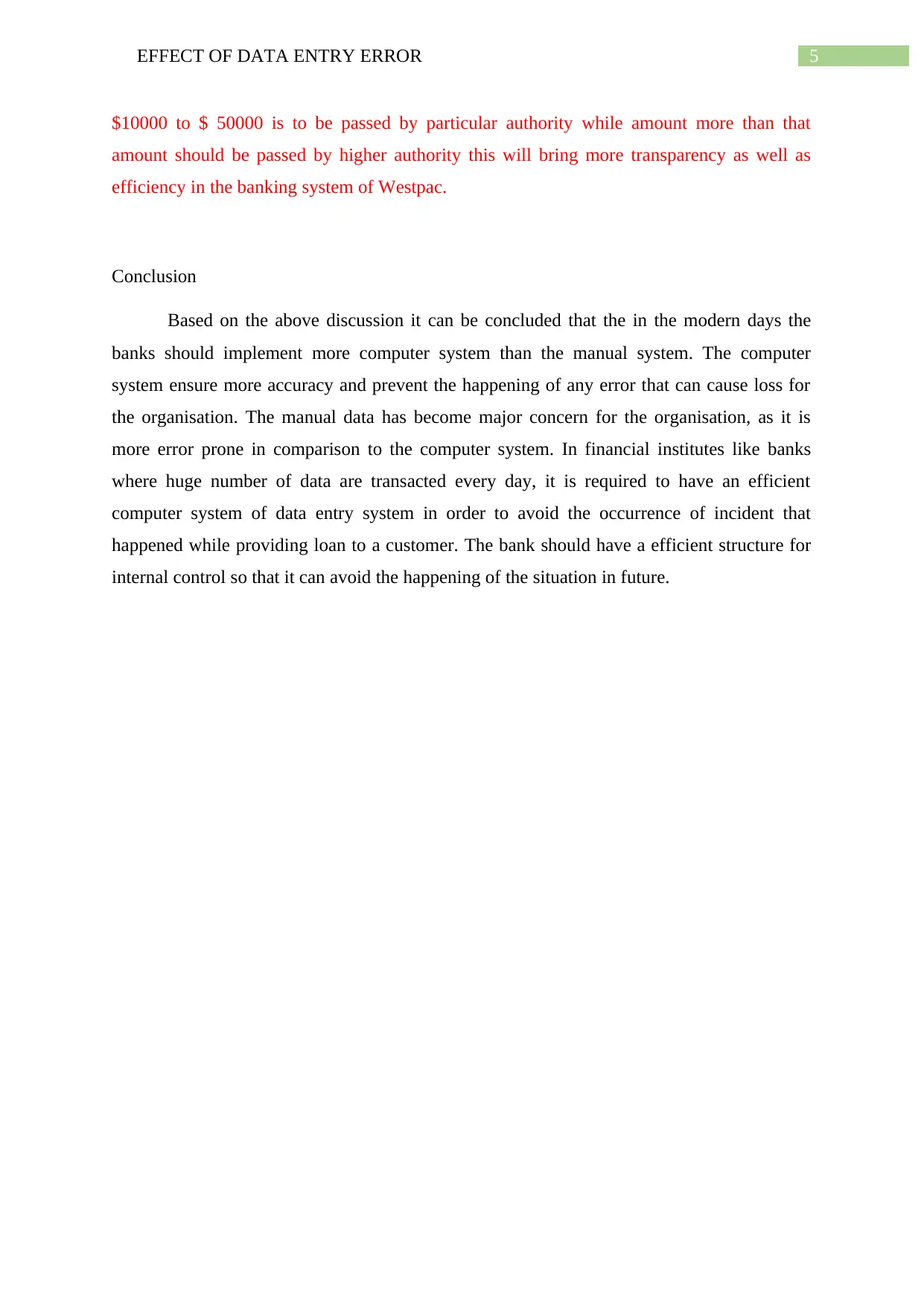
5EFFECT OF DATA ENTRY ERROR
$10000 to $ 50000 is to be passed by particular authority while amount more than that
amount should be passed by higher authority this will bring more transparency as well as
efficiency in the banking system of Westpac.
Conclusion
Based on the above discussion it can be concluded that the in the modern days the
banks should implement more computer system than the manual system. The computer
system ensure more accuracy and prevent the happening of any error that can cause loss for
the organisation. The manual data has become major concern for the organisation, as it is
more error prone in comparison to the computer system. In financial institutes like banks
where huge number of data are transacted every day, it is required to have an efficient
computer system of data entry system in order to avoid the occurrence of incident that
happened while providing loan to a customer. The bank should have a efficient structure for
internal control so that it can avoid the happening of the situation in future.
$10000 to $ 50000 is to be passed by particular authority while amount more than that
amount should be passed by higher authority this will bring more transparency as well as
efficiency in the banking system of Westpac.
Conclusion
Based on the above discussion it can be concluded that the in the modern days the
banks should implement more computer system than the manual system. The computer
system ensure more accuracy and prevent the happening of any error that can cause loss for
the organisation. The manual data has become major concern for the organisation, as it is
more error prone in comparison to the computer system. In financial institutes like banks
where huge number of data are transacted every day, it is required to have an efficient
computer system of data entry system in order to avoid the occurrence of incident that
happened while providing loan to a customer. The bank should have a efficient structure for
internal control so that it can avoid the happening of the situation in future.
⊘ This is a preview!⊘
Do you want full access?
Subscribe today to unlock all pages.

Trusted by 1+ million students worldwide
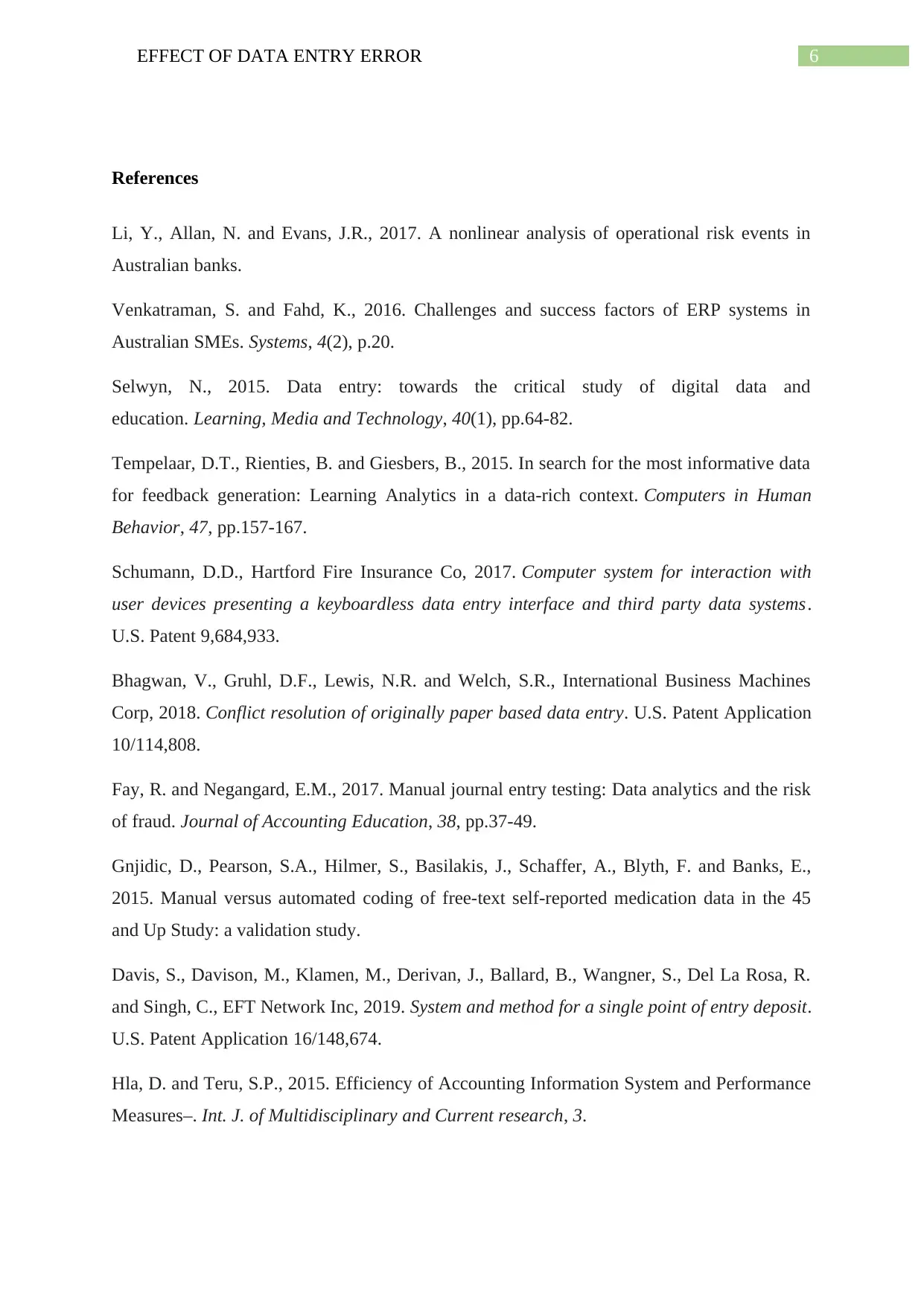
6EFFECT OF DATA ENTRY ERROR
References
Li, Y., Allan, N. and Evans, J.R., 2017. A nonlinear analysis of operational risk events in
Australian banks.
Venkatraman, S. and Fahd, K., 2016. Challenges and success factors of ERP systems in
Australian SMEs. Systems, 4(2), p.20.
Selwyn, N., 2015. Data entry: towards the critical study of digital data and
education. Learning, Media and Technology, 40(1), pp.64-82.
Tempelaar, D.T., Rienties, B. and Giesbers, B., 2015. In search for the most informative data
for feedback generation: Learning Analytics in a data-rich context. Computers in Human
Behavior, 47, pp.157-167.
Schumann, D.D., Hartford Fire Insurance Co, 2017. Computer system for interaction with
user devices presenting a keyboardless data entry interface and third party data systems.
U.S. Patent 9,684,933.
Bhagwan, V., Gruhl, D.F., Lewis, N.R. and Welch, S.R., International Business Machines
Corp, 2018. Conflict resolution of originally paper based data entry. U.S. Patent Application
10/114,808.
Fay, R. and Negangard, E.M., 2017. Manual journal entry testing: Data analytics and the risk
of fraud. Journal of Accounting Education, 38, pp.37-49.
Gnjidic, D., Pearson, S.A., Hilmer, S., Basilakis, J., Schaffer, A., Blyth, F. and Banks, E.,
2015. Manual versus automated coding of free-text self-reported medication data in the 45
and Up Study: a validation study.
Davis, S., Davison, M., Klamen, M., Derivan, J., Ballard, B., Wangner, S., Del La Rosa, R.
and Singh, C., EFT Network Inc, 2019. System and method for a single point of entry deposit.
U.S. Patent Application 16/148,674.
Hla, D. and Teru, S.P., 2015. Efficiency of Accounting Information System and Performance
Measures–. Int. J. of Multidisciplinary and Current research, 3.
References
Li, Y., Allan, N. and Evans, J.R., 2017. A nonlinear analysis of operational risk events in
Australian banks.
Venkatraman, S. and Fahd, K., 2016. Challenges and success factors of ERP systems in
Australian SMEs. Systems, 4(2), p.20.
Selwyn, N., 2015. Data entry: towards the critical study of digital data and
education. Learning, Media and Technology, 40(1), pp.64-82.
Tempelaar, D.T., Rienties, B. and Giesbers, B., 2015. In search for the most informative data
for feedback generation: Learning Analytics in a data-rich context. Computers in Human
Behavior, 47, pp.157-167.
Schumann, D.D., Hartford Fire Insurance Co, 2017. Computer system for interaction with
user devices presenting a keyboardless data entry interface and third party data systems.
U.S. Patent 9,684,933.
Bhagwan, V., Gruhl, D.F., Lewis, N.R. and Welch, S.R., International Business Machines
Corp, 2018. Conflict resolution of originally paper based data entry. U.S. Patent Application
10/114,808.
Fay, R. and Negangard, E.M., 2017. Manual journal entry testing: Data analytics and the risk
of fraud. Journal of Accounting Education, 38, pp.37-49.
Gnjidic, D., Pearson, S.A., Hilmer, S., Basilakis, J., Schaffer, A., Blyth, F. and Banks, E.,
2015. Manual versus automated coding of free-text self-reported medication data in the 45
and Up Study: a validation study.
Davis, S., Davison, M., Klamen, M., Derivan, J., Ballard, B., Wangner, S., Del La Rosa, R.
and Singh, C., EFT Network Inc, 2019. System and method for a single point of entry deposit.
U.S. Patent Application 16/148,674.
Hla, D. and Teru, S.P., 2015. Efficiency of Accounting Information System and Performance
Measures–. Int. J. of Multidisciplinary and Current research, 3.
1 out of 7
Related Documents
Your All-in-One AI-Powered Toolkit for Academic Success.
+13062052269
info@desklib.com
Available 24*7 on WhatsApp / Email
![[object Object]](/_next/static/media/star-bottom.7253800d.svg)
Unlock your academic potential
Copyright © 2020–2025 A2Z Services. All Rights Reserved. Developed and managed by ZUCOL.





